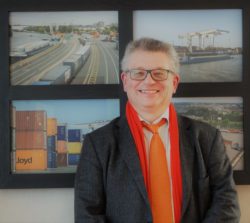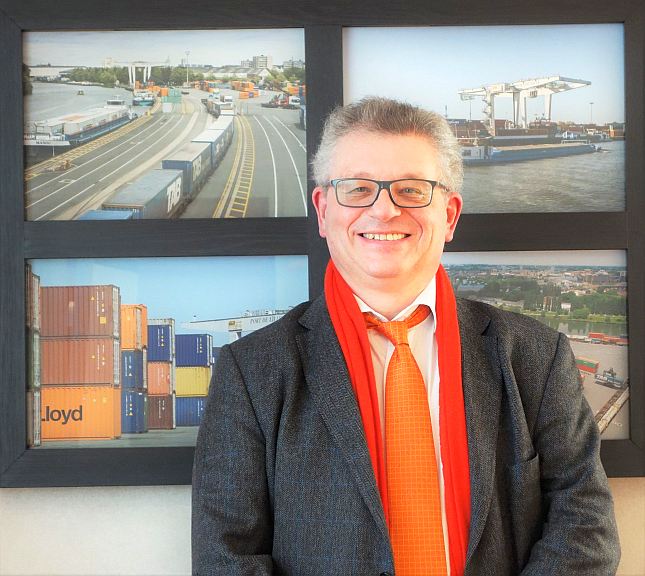 While the Urban Multimodal Distribution Centre is taking time to get up to speed, the task of integrating Ports de Lille into the metropolitan and regional fabric is more strategically important than ever.
While the Urban Multimodal Distribution Centre is taking time to get up to speed, the task of integrating Ports de Lille into the metropolitan and regional fabric is more strategically important than ever.
Relying on 12 sites along the wide canals of the Hauts-de-France region, Ports de Lille is looking for innovative ways to meet the needs of logistics operators, who are faced with the daily challenges posed by e-commerce at the heart of France’s fourth-largest city.
Alain Lefebvre, Chief Executive of Ports de Lille, gives us more insight into the relationship between these ports and the territory in which they are based.
The Urban Multimodal Distribution Centre will turn five years old in 2020. It has been the starting point for a port integration strategy that is in effect daily across the Lille area. What is your verdict on these first five years?
As France’s fourth largest inland port in terms of tonnage, Ports de Lille aims to position itself as a responsible, committed operator within the metropolitan landscape. Aware of the challenges posed by changing modes of consumption and the impact of goods transport in urban environments, in 2015 we invested in the construction of an Urban Multimodal Distribution Centre (known by the initials CMDU). Our aim was to provide a facility for mass transport of goods from outside the city, by water, rail or road, and then their distribution to outlets inside the city.
Sited in a densely built-up area, the CMDU is a real asset for ecomobility, helping to ease congestion in the city of Lille and optimise last mile logistics. The CMDU has good road, rail and river connections, and is a genuine logistics platform serving the needs of traders, retailers and transporters in the city.
Unfortunately, given the lack of institutional support, the CMDU has been unable to carve out a real place for itself in the existing urban environment. Since it was launched in 2015, two operators (Véolia and Oxipio) have tried without success to invest in a range of urban logistics services. The issues of mobility and (metropolitan) regulations meant there was little incentive to make use of the facility. This year, we signed an agreement with a third operator, in the hope that their economic model for urban logistics will be more sustainable, given that the institutional outlook also appears more favourable.
Today, given new consumer habits and climate issues, how are you planning to develop the centre? What are the major logistical challenges?
With the advent of the digital age, urban distribution processes are becoming increasingly complex, and demand an urban organisation that encourages just in time deliveries. It is no longer just about delivering goods into the city, but actually providing a whole range of services for consumers (pick-up points, vehicle reception points, multimodal supply, floating stock, logistics hotels, etc.).
With this in mind, Ports de Lille is making its multi-purpose urban logistics platform available to traders, logistics operators and transporters. Logistics hubs like our CMDU, in collaboration with other sites, are capable of handling substantial flows of palletised and containerised goods, acting as the interface between mass transport and fine distribution. It allows operations like “cross-docking” of lightweight goods (swap bodies, packages) by providing users with handling equipment, premises, parking and facilities for vehicles (there is already a CNG station available).
Ports de Lille is currently engaged in a process of complete transformation towards social responsibility. We are working with various regional partners to deploy new projects as part of a collective approach to the digital and energy transition. Projects like the multi-energy station, the Roquette project, REV3, supply chain’s digital twin, ISO 9001, OEA and BREEAM certifications are just some examples of our firm commitment to meeting the present and future needs of shippers, logistics operators, and society in general.
Ports de Lille occupies a privileged location in the heart of the city and enjoys partnerships with the seaports of Dunkirk, Calais and Antwerp. How do you position yourself in that environment?
As one of the most heavily industrialised regions of France, the Hauts-de-France is focused on logistics as an economic growth engine. Located between the great capitals of north-western Europe, our region is also a crossroads for huge flows of goods. The port is home to a wide variety of businesses in sectors ranging from construction, storage, transport and logistics to recycling, office rental and the food industry.
Like all inland ports, Ports de Lille is aiming to strengthen its hinterland positioning by integrating with international logistics chains to become a genuine platform between transport, production and distribution. We are developing multimodal services at the entrance to the Lille conurbation for the benefit of the city and regional industrial operators.
Ports de Lille is one of the founding partners of Norlink, the regional federation of logistics chain stakeholders (sea, rail, river, recreational sailing). The aim is to bring the region’s strengths together at the same table, in order to identify better solutions to the challenges of multimodal transport on a larger scale. In this context, the sea ports and inland platforms are partners, with whom we share a range of issues: modal shift, regional promotion, sustainable development, safety/security and digitisation.
Work will begin on the new North Seine Canal in 2020, with the waterway due to open gradually from 2028. That is both a short and a long-term timeframe. How is Ports de Lille preparing?
The Europe North Seine Canal (CSNE) is a priority project for the Hauts-de-France region, intended to support the redployment of industrial activities accessible for mass transport and alternatives to road haulage. It is in our common interest and complements Ports de Lille’s own strategy.
The stronger the region’s industrial activity, the more opportunity there will be for mass freight on inland platforms.
Like all economic operators, we are eagerly awaiting investments in the future platforms (Marquion, Noyon, Péronne, Nesle). The Albert Canal, the Brussels-Charleroi Canal, and the Dutch canals are examples of best practices.
* just in time: a manufacturing system that minimizes stocks and storage.
*Cross-docking: a method of preparing orders that eliminates the need for warehousing and order picking goods.
*GNC: Compressed Natural Gaz.





